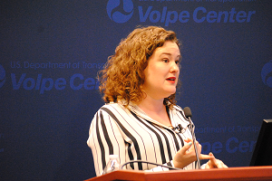Beyond Big Data to Useful Data
The value of large data sets in support of decision making is so well known that it has spawned a seemingly endless array of related names and techniques: from big data to competitive intelligence to data analytics to predictive modeling to business analytics to knowledge management to predictive analytics to business intelligence to data warehousing to information management to data-driven decision-making to data mining to prescriptive analytics.
“How do we turn this convergence of buzzwords into something really concrete and useful and go beyond the hype?” asked Laura Schewel, founder and chief executive officer of StreetLight Data, who spoke as part of the U.S. DOT Volpe Center’s Our New Mobility Future series.
Making the Data We Have Actionable
StreetLight Data describes data as just a cost—until it is put to work. To add value, the data needs to be properly and intuitively analyzed in order to turn it into actionable analytics. Schewel explained that it is hard to make policy with just data.
“All of this data is out there, but that is not useful big data. You can’t make a policy about that road based on that data…you have to turn that data into something useful,” Schewel said. “It is imperative that we adopt a stance of having persistent, independent impact metrics as new mobility [service-based transportation business models including mobility on demand, mobility as a service, and shared mobility] hits the roads, and that means impact on congestion, on accessibility, on climate, on jobs, everything.”
Watch a video highlight about applications for big data from Schewel's talk as part of the Volpe Center's 2019 speaker series, Our New Mobility Future.
Finding Mobility Data on Pedestrians
Getting large volumes of detailed data from automobiles can be straightforward, given the number of contemporary cars with built-in navigation systems and network connectivity, as well as similar systems in use on drivers’ phones, Schewel said. But what about for pedestrians, cyclists, scooters, and so on?
“Almost every human in America has put a mobile sensing device into their pocket,” she said.
With that insight, cell phones using opt-in tracking apps became an additional source of their transportation data set, she said. At this time, they see 60- to 70-million phones in the United States and Canada in addition to connected cars and trucks; pedestrian and other data is now known and available for analysis and decision making.
Continuing Data Challenges
Additional remaining challenges include the serious consideration of privacy—even with anonymized movements—and basic road and other transportation maintenance.
“It’s critical for the industry that we all take a very rigorous approach to data privacy because this data is extremely powerful,” Schewel said, emphasizing that one cannot be too cavalier about raw, individualized travel data.
“Big data is powerful, and anything powerful can do some really amazingly good stuff for society and can do some not so good stuff…we have to balance those concerns,” she said.
Ironically, her most desired high-tech item is hardly a technology at all and is something that all road users—not just computers—can benefit from: road maintenance. Due to the ability of road maintenance to make the job of driving easier and safer for automated vehicles as well as for human drivers, pedestrians, and cyclists, Schewel declared that, “The most important new mobile technology that we all need to work on is paint.”

